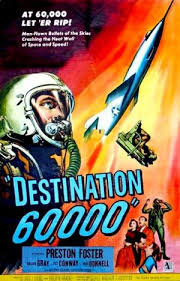Plot
A new experimental aircraft, "The Dream" is the pride of the Buckley Aircraft Corporation. Owner Colonel Ed Buckley (Preston Foster), has designed and built a prototype that his former wartime flying buddy, Jeff Connors (Pat Conway), wants to fly. Buckley's wife Ruth likes Jeff, who is godfather to their son "Skip" (Bobby Clark). Test flying is dangerous work, and Jeff has to learn how to fly to supersonic speeds, coached by Mickey Hill (Denver Pyle). Ed's secretary, Mary Ellen (Coleen Gray), is another reason for Jeff to want to join the company.
Although Mickey is scheduled to do the first test, his wife Grace (Anne Barton) is expecting, so Ed assigns Jeff. "The Dream" is carried to altitude by a Boeing B-29/P2B mothership before being released to fly on its own power. When Jeff tries to ignite the rocket motors, the aircraft explodes. but he ejects using an escape pod, landing safely. Suspected of somehow being responsible for the explosion, he is placed on a 30-day suspension, but Jeff protests and quits. With his partner Dan Maddox (Russell Thorson), Ed constructs a second prototype, with Mickey as the test pilot.
A repeat of the same explosion lands Mickey in the hospital. He had blacked out, but the automatic escape pod had deployed, saving his life. In a visit to the hospital where he sees Ed, Jeff asks to come back, claiming he will serve his suspension while a new aircraft is being built. With his company's fortunes at a low ebb, Ed believes he has the answer to the violent explosions and elects to fly the next test himself. Jeff accompanies him. "The Dream" climbs to 60,000 feet, then Ed cuts the motors and reignites them successfully, but blacks out. Jeff sends out a Mayday, shouting, "Bandits at two o'clock." Like he had in wartime, Ed instinctively reacts and pulls out of the dive. With the test a success and the company again in good shape, Ed and Jeff land safely and return to Ruth and Mary, who are waiting for them.
Reception
Destination 60,000 was primarily a B film, "one of a cycle of late-1950s films dealing with the exploits of supersonic-jet test pilots. ... Destination 60,000 was put together by Gross-Krasne Productions, a firm more closely associated with weekly TV series (Big Town, Dr. Hudson's Secret Journal, Mayor of the Town, etc.)." [3]
This page is based on this
Wikipedia article Text is available under the
CC BY-SA 4.0 license; additional terms may apply.
Images, videos and audio are available under their respective licenses.

